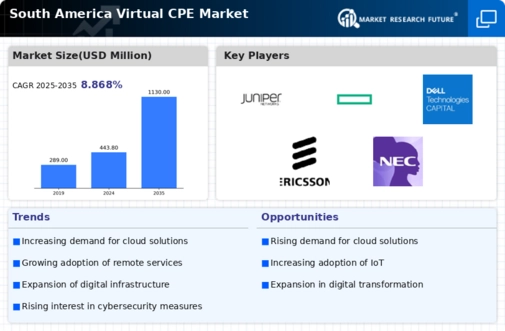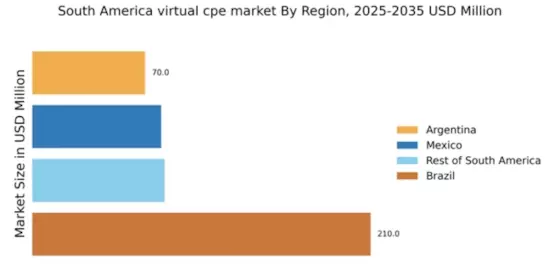Increased Focus on Customer Experience
In South America, there is an increased focus on enhancing customer experience, which is influencing the virtual cpe market. Businesses are recognizing that superior customer service is a key differentiator in a competitive landscape. As a result, organizations are investing in technologies that enable them to deliver seamless and personalized experiences. The virtual cpe market is responding to this demand by providing solutions that facilitate better service delivery and customer engagement. By leveraging virtual cpe technologies, companies can optimize their network performance, ensuring that customers receive reliable and high-quality services. This emphasis on customer experience is likely to drive further adoption of virtual cpe solutions, as businesses seek to align their operational strategies with customer expectations, ultimately leading to improved satisfaction and loyalty.
Rising Need for Cost-Effective Solutions
The virtual cpe market in South America is significantly influenced by the rising need for cost-effective networking solutions. Businesses are increasingly pressured to optimize operational costs while maintaining high service quality. Virtual cpe solutions offer a compelling alternative to traditional hardware-based systems, enabling organizations to reduce capital expenditures and operational costs. Reports indicate that companies can save up to 30% on networking expenses by transitioning to virtualized solutions. This financial incentive is driving the adoption of virtual cpe technologies across various sectors, including telecommunications and enterprise IT. As organizations seek to streamline their operations and enhance profitability, the virtual cpe market is likely to see sustained growth, with an emphasis on delivering value-driven solutions that align with budgetary constraints.
Regulatory Support for Digital Transformation
In South America, regulatory frameworks are evolving to support digital transformation initiatives, which significantly impacts the virtual cpe market. Governments are implementing policies that encourage the adoption of advanced technologies, including virtualized network functions. This regulatory support is crucial as it fosters an environment conducive to innovation and investment in the virtual cpe market. For instance, initiatives aimed at improving broadband access and promoting competition among service providers are likely to enhance the market landscape. As a result, businesses are more inclined to invest in virtual cpe solutions, anticipating favorable conditions for growth. The alignment of regulatory policies with technological advancements suggests a promising future for the virtual cpe market in the region, potentially leading to increased market penetration and diversification of service offerings.
Growing Demand for Flexible Networking Solutions
The virtual cpe market in South America experiences a notable surge in demand for flexible networking solutions. Enterprises are increasingly seeking to adapt their network infrastructures to accommodate remote work and digital transformation initiatives. This shift is evidenced by a projected growth rate of approximately 15% annually in the region. Organizations are recognizing the need for scalable and agile networking options that can be deployed rapidly. As businesses strive to enhance operational efficiency, the virtual cpe market is positioned to benefit from this trend, offering solutions that enable seamless integration of various services and applications. The ability to customize network configurations to meet specific business needs further drives the adoption of virtual cpe solutions, making them an attractive option for companies aiming to remain competitive in a dynamic market.
Technological Advancements in Network Virtualization
Technological advancements in network virtualization are playing a pivotal role in shaping the virtual cpe market in South America. Innovations such as software-defined networking (SDN) and network function virtualization (NFV) are enabling service providers to offer more efficient and flexible solutions. These technologies allow for the decoupling of hardware and software, facilitating easier management and deployment of network services. The virtual cpe market is witnessing an influx of new players and solutions that leverage these advancements, enhancing competition and driving down costs. As organizations increasingly recognize the benefits of adopting virtualized network solutions, the market is expected to expand. The integration of artificial intelligence and machine learning into network management further indicates a trend towards smarter, more adaptive networking solutions, which could redefine operational capabilities in the region.


















Leave a Comment